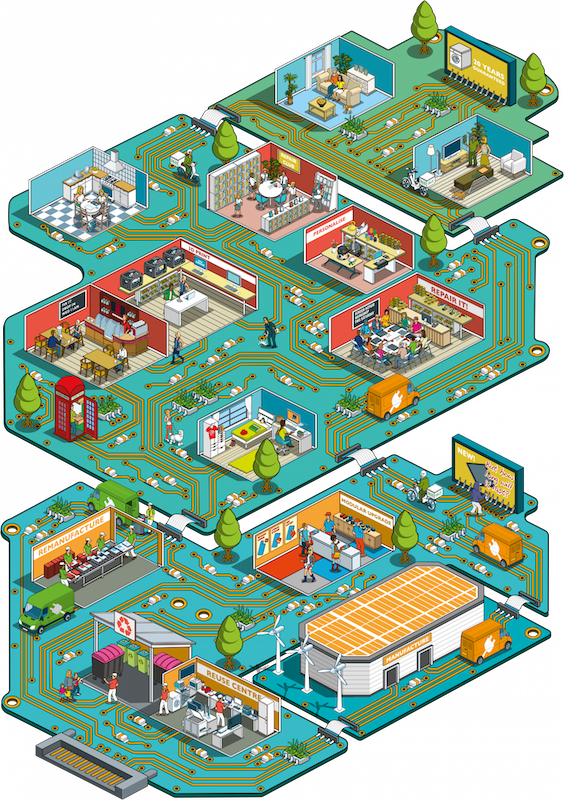
The internet does not begin and end in a data centre. Our devices have physical impacts that we must confront, too. We envision futures that move towards a more repairable relationship with our devices. And we begin with what is already in our pockets and our homes.
The Restart Project is a small social enterprise that started with events called “Restart Parties”—bringing people together to share skills and gain the confidence to open up their devices and technology. By promoting repair, we give people a hands-on way of making a difference, as well as a way to talk about the wider issue of what kind of products and future we want.
Taking the design of a circuit board for inspiration—the operative heart of our devices—our Restarted Future poster illustrates the life-force of a future, a sustainable economy.
There are so many possibilities to move towards a better relationship with our devices. Our vision is modular, which means its parts can be taken apart and reconfigured so that the vision remains “upgradeable”.
Currently, there are examples of all of these possibilities in action:
- communities maintaining operating systems for computers, routers and mobiles deemed “obsolete” by manufacturers
- schools that have their own student-run repair centre, like this one in New York City
- creative upgrades and “modding” of older iPods and various other equipment
- community repair groups incorporating 3D printing of spare parts into their events
- mobile and pop-up repair businesses
However change needs to happen on multiple levels for real system change to emerge.
Right to Repair: old barriers and new
Even as we glimpse flashes of the futures we are seeking, we are seeing new barriers to longer- lasting products emerge. They compound the existing barriers we’ve been campaigning to remove since the beginning: design for repair, access to spare parts and repair documentation.
New software locks that are embedded in hardware make repair and reuse harder, both in mobiles and laptops and also other connected devices and appliances.
As more and more consumer technology requires constant connection to the internet, the goalposts of ownership are shifting. Our ability to continue using our devices is becoming more and more mediated by the companies that sold them to us.
Often companies impose these barriers in ways that are not immediately visible or comprehensible: for example, they might only become evident after a software update, disabling a device previously repaired by non “authorised” technicians.
Product as a service? Yes, but…
Many people ask us what we think about “product as a service” models. These are where users pay for access, and it essentially functions as a rental. We think this model could suit many people, but it cannot be the only one.
We cannot fathom a future where people do not have the option to buy, modify and repair their own equipment. This absolutely must exist in parallel to the growth of alternative, convenience-based business models where companies exert control over the full lifecycle of products.
We are creative, and we are problem solvers. Repair and play are hardwired human instincts, just like our love for the shiny new thing.
Further reading
Download the original PDF
Listen to the Restart Podcast
About the author
Janet Gunter is the Outreach Lead and Co-Founder of the Restart Project. She gives regular talks on consumer technology and sustainable economy. She is an American/British activist and anthropologist who has lived and worked in Brazil, East Timor, Portugal and Mozambique.
